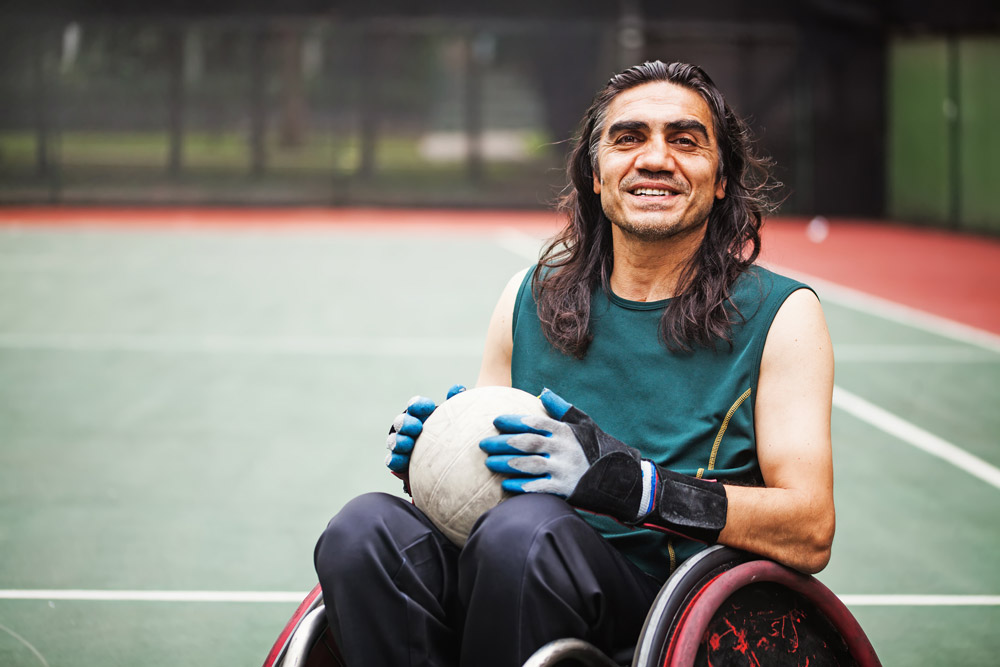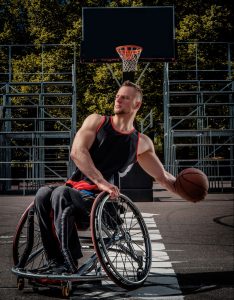Physiotherapy for people with a spinal cord injury
What is a spinal cord injury?
A spinal cord injury (SCI) is any injury which causes damage to the spinal cord – the bundle of nerves which carries messages between the brain and body. The spinal cord runs through a canal between the bones of the spine, which helps to protect it. However, diseases and injuries can affect the spinal cord, leading to a wide range of consequences. Movement and sensation are commonly affected. A spinal cord injury can also lead to changes in breathing, the ability to regulate body temperature, and bladder, bowel, and sexual function.
No two spinal cord injuries are the same. The effects first depend on where the spinal cord is damaged. An injury that occurs in the neck leads to tetraplegia (also known as quadriplegia), which means the arms and legs are affected. A spinal cord injury in the back leads to paraplegia, which means the legs and torso are affected, but not the arms.
Injury severity also affects the outcomes. Some injuries have minimal impact and people recover from them completely, while others result in complete paralysis below the injured level.
According to Spinal Cure Australiai (a not-for-profit organisation raising funds to find a cure for SCI), one person experiences a spinal cord injury every day in Australia, while more than 20,000 people live with an SCI across the country. Most spinal cord injuries in Australia are incomplete, which means the spinal cord is not completely severed.

Physiotherapy rehabilitation for spinal cord injury focuses on improving function and reducing secondary effects of the injury
Spinal cord injury causes
In Australia, land transport crashes (such as motorbike and quad bike accidents) are the most common traumatic cause of spinal cord injuries, followed by fallsii. Other causes include sports injuries and diseases that affect the spine (such as spina bifida and multiple sclerosis).
SCI is a life-long condition, and there is currently no cure. Rehabilitation focuses on improving function and independence and minimising any secondary effects of the injury (such as shoulder pain and lung problems) to optimise independence and quality of life.
Spinal cord injury physiotherapy management: an overview
After a spinal cord injury, physiotherapy usually begins early and aims to prevent and manage respiratory and circulatory complications and the impact of immobilisation. Following this stage, people begin rehabilitation, which often occurs in a specialised spinal cord injury unit but may start in the acute care facility.
Rehabilitation considers the whole person and is focused on facilitating maximum independence and helping the person prepare for getting back to their home and chosen lifestyle. Physiotherapy plays a vital role in achieving this.
Physiotherapy management of spinal cord injury under the NDIS
After the initial rehabilitation period, physiotherapy through the NDIS can help to address the complex, ongoing needs and challenges often faced by people affected by SCI. NDIS physiotherapists work with people living with a disability related to SCI to help prevent complications and further improve their function, independence, and ability to participate in home, work, community life, and sport and leisure activities.
For people with a spinal cord injury, NDIS physiotherapy will involve:
- Discussing your health history, therapy goals and circumstances (such as your home and work situation, availably of support, and other factors which may influence how therapeutic support is delivered).
- An assessment of your current functional capacity and ability to participate in important activities.
- Setting relevant goals.
- Identifying any barriers that could limit the achievement of your goals.
- Identifying and delivering physiotherapy treatments (such as strengthening exercises, pain management techniques, and motor skill development) to support achievement of your goals.
- Measuring therapy outcomes and adjusting goals and treatments accordingly.
If you have an SCI, your NDIS physiotherapist will customise a program for you. This means spinal cord injury physiotherapy will look a bit different for each person. Depending on your needs and goals, physio for people with SCI might also involve prescription of assistive technologies that will help you achieve them, such as mobility aids.
How physiotherapy can help people living with a spinal cord injury
A spinal cord injury can lead to a wide range of consequences, so spinal cord injury physiotherapy involves various techniques and strategies. Your physiotherapist will help work towards your goals using recognised, evidence-based therapies.
Common examples of physiotherapy for spinal cord injury include:
Gait (walking) training
If you are able to walk, your physiotherapist might design a program to enhance the quality or speed of your gait, or your ability to walk longer distances. This may involve the use of splints or assistive devices (such as crutches) if needed. It might also include exercises designed to strengthen specific muscle groups or improve your balance to foster better mobility.
Wheelchair training
If you’re using a wheelchair, physiotherapy might involve working on your seating position and posture to optimise efficiency and comfort. You might also practice using the wheelchair in your community, and over different terrains such as slopes, gutters, and uneven ground. Your physio might also work on your endurance, falls prevention/recovery techniques, and support you to get involved in wheelchair sport.
Bed mobility and transfer training
An SCI can affect your ability to move around in bed and transfer safely and effectively. Your physiotherapist can train you to roll over and sit up in bed, and to transfer in and out of bed and on and off chairs and the toilet.
Balance training
Muscle weakness and sensory changes affect balance, so physiotherapy may involve training to maintain or improve your balance in sitting and standing. Regular standing practise can help with improving spasticity, blood pressure control, bone mineral density and bladder and bowel function. If independent standing isn’t possible, this may be achieved using assistive devices such as splints, frames, or a standing wheelchair.
Maintaining fitness and physical health
Regular exercise is an essential part of a healthy lifestyle and helps to reduce your risk for developing numerous health conditions, including type 2 diabetes and cardiovascular disease. This is particularly important for people living with SCI, with research showing they are at higher risk for developing these conditions iii,iv. However, research also shows that people with a spinal cord injury have lower average levels of physical activity compared to the general populationv.
Physiotherapy can help you stay healthy and fit by supporting you to get involved in a regular exercise routine, which may include the use of adaptive equipment. An accredited exercise physiologist can also help with this.

Physiotherapists help people with a spinal cord injury to achieve their goals
Maintaining mental health
Similarly, research shows that compared to uninjured people, those living with a spinal cord injury are at a higher risk of developing mental health conditions (including depression and anxiety)vi, along with higher levels of distress and lower levels of life satisfactionvii. Regular exercise is proven to support mental wellbeing and positive mood, and to ease anxiety and depression symptoms.
Contracture prevention
Paralysis and spasticity can lead to muscle shortening and joint stiffness, which can adversely affect function. Physiotherapy techniques such as positioning and stretches can reduce the risk of developing contractures or help to manage existing ones.
Strength training
Muscle weakness is one of the primary features of spinal cord injury and physiotherapy usually involves strengthening exercises. Your strength training program will be focused on helping you achieve a goal, such as improving your shoulder strength for wheelchair mobility or improving leg strength for standing balance and walking.
Breathing function
A spinal cord injury to the neck can affect the muscles involved in breathing, potentially leading to problems such as chest infections. Physiotherapy can help with training in breathing techniques and assisted coughing.
Pain management
Pain is very common in people living with a spinal cord injury, with up to 70% experiencing pain for more than six monthsviii. This includes musculoskeletal pain caused by muscle spasms or altered use of the arms or shoulders, along with pain caused by changes in nervous system function (known as neuropathic pain).
Physiotherapy techniques such as pain education, exercises, and manual therapies may help to relieve pain and restore function.
NDIS physiotherapy for people with spinal cord injuries
At Active Ability, our NDIS registered physiotherapists understand that people who’ve had a spinal cord injury face significant challenges throughout their lives.
Our experienced, caring team will work alongside you, as well as your support team, to devise a treatment plan tailored to your needs and goals. Our team also includes NDIS registered clinical dietitians and accredited exercise physiologists, so we can provide multidisciplinary support for optimising your wellbeing and quality of life.
We don’t have a waiting list or charge for travel, so you can get started with treatment right away and make the best use of your NDIS funding.
To learn more about how we might be able to help you, contact our friendly team on (02) 8678 7874, hello@activeability.com.au or via our contact form.
REFERENCES:
[i] – Spinal Cure Australia. Spinal Cord Injury Facts. https://www.spinalcure.org.au/research/spinal-cord-injury-facts/. Accessed online 1.8.2022.
[ii] – Australian Institute of Health and Welfare. Spinal cord injury, Australia 2017–18. https://www.aihw.gov.au/reports/injury/spinal-cord-injury-australia-2017-18/summary. Accessed online 1.8.2022.
[iii] – Neurology. Spinal cord injury and type 2 diabetes: Results from a population health survey. https://n.neurology.org/content/81/21/1864.short. Accessed online 1.8.2022.
[iv] – Neurology. Cardiovascular disease and spinal cord injury: Results from a national population health survey. https://n.neurology.org/content/81/8/723.short . Accessed online 1.8.2022.
[v] – Scientific Reports. A national survey of physical activity after spinal cord injury. https://www.nature.com/articles/s41598-022-07927-5. Accessed online 1.8.2022.
[vi] – Mayo Clinic Proceedings. Psychological Morbidity and Chronic Disease Among Adults With Traumatic Spinal Cord Injuries. https://www.mayoclinicproceedings.org/article/S0025-6196(19)31094-8/fulltext. Accessed online 1.8.2022.
[vii] – Spinal Cord. Psychosocial issues in spinal cord injury: a review. https://www.nature.com/articles/sc2011182 . Accessed online 1.8.2022.
[viii] – Agency for Clinical Innovation: Pain Management Network. Spinal Cord Injury Pain https://aci.health.nsw.gov.au/chronic-pain/spinal-cord-injury-pain. Accessed online 1.8.2022.